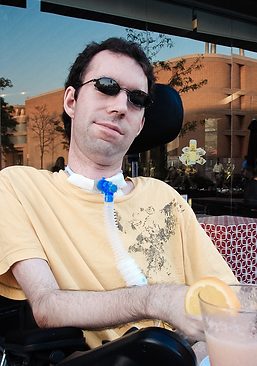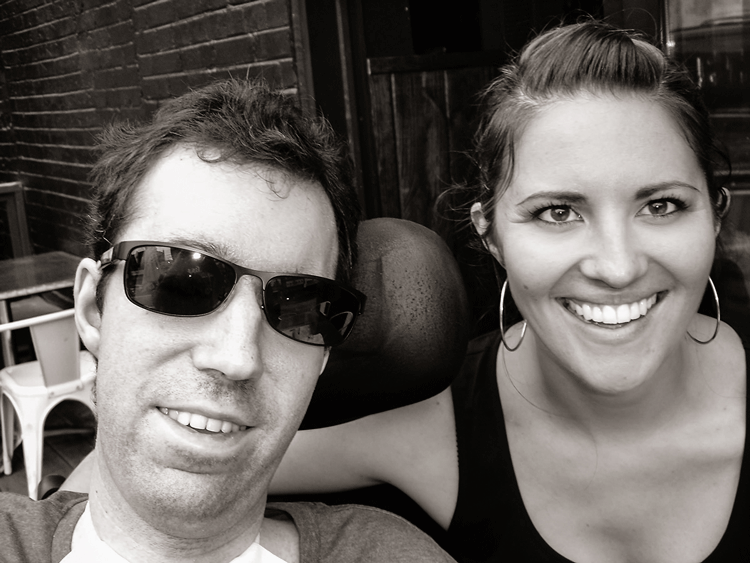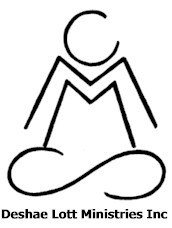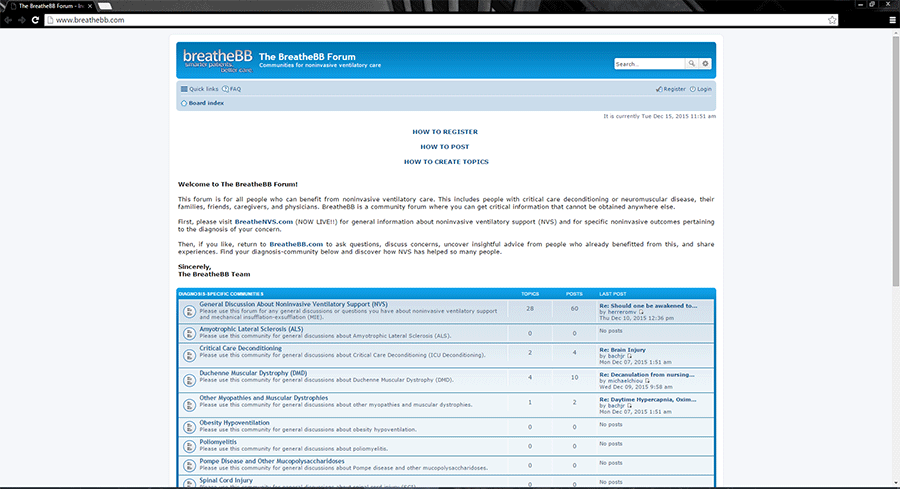IVUN
INTERNATIONAL VENTILATOR USERS NETWORK
an affiliate of Post-Polio Health International
CONNECTING
VENTILATOR USERS,
HEALTH PROFESSIONALS,
AND INDUSTRY
IVUN
INTERNATIONAL VENTILATOR USERS NETWORK
an affiliate of Post-Polio Health International
CONNECTING
VENTILATOR USERS,
HEALTH PROFESSIONALS,
AND INDUSTRY
VENTILATOR-ASSISTED LIVING
This issue sponsored by:

VOLUME 29, NUMBER 6
DECEMBER 2015
Justin Robshaw, Just Design Studio, Toronto, Canada
My name is Justin and I’m 28 years old. I was born with a rare neuromuscular disorder called centronuclear myopathy that affects my large muscles. Despite my condition not being progressive, I did have some setbacks that lead me to gradually lose my mobility and forced me to use a manual wheelchair during most of my high school years.
I had a really hard time accepting that state of my life; even more so when I needed a power wheelchair during my senior year and then realizing that it was going to be permanent. As hard as it was that year, I came to accept the fact of using a power chair and to not worry about how I looked physically and what my friends and other people thought of me........MORE
Jeff DeTray, Napoleon, Ohio
I procrastinated and it was not until the spring of 2015 that I began to pursue a new breathing device in earnest. I was not looking forward to the process of contacting my durable medical equipment (DME) provider, determining the requirements for Medicare coverage and going through the tests. However, when I finally did take action, it was not as difficult as I expected!
I visited my DME and talked with a new respiratory therapist (RT). Contrary to my previous experience, she was knowledgeable about Medicare coverage and said I would require a new sleep study. This was not a surprise.........MORE
ADDITIONAL SECTIONS
Margaret Pfrommer Memorial Lecture
Networking
Sharing the work of others.
Advocacy
Educate, discuss, take action.
Recent Relevent Publications
Summaries, links to selected professional, disability, disease journals and newsletters.
Educational Opportunities
Conferences and webinars for health professionals and ventilator users.
Industry
The business of living with a ventilator.
Supported by:
Ventilator-Assisted Living
Vol. 29, No. 6, December 2015
Editor: Joan L. Headley
Designer: Brian Tiburzi
ISSN 1066-534X
© 2015 Post-Polio Health International.
Permission to reprint must be obtained from Post-Polio Health International (PHI) at info@post-polio.org.
Ventilator users, health professionals, non-profits, company representatives – send comments and updates to info@ventusers.org.
Tubes Will Not Defeat Me
Justin Robshaw, Just Design Studio, Toronto, Canada
My name is Justin and I’m 28 years old. I was born with a rare neuromuscular disorder called centronuclear myopathy that affects my large muscles. Despite my condition not being progressive, I did have some setbacks that lead me to gradually lose my mobility and forced me to use a manual wheelchair during most of my high school years.
I had a really hard time accepting that state of my life; even more so when I needed a power wheelchair during my senior year and then realizing that it was going to be permanent. As hard as it was that year, I came to accept the fact of using a power chair and to not worry about how I looked physically and what my friends and other people thought of me. That was for me, a significant self-accomplishment that allowed me to focus on preparing myself for college.

While studying graphic design in college as a full-time student, I worked very hard to meet all deadlines, despite the recommendations of the professors to take extra time completing project assignments. I wanted to be treated the same as everyone else, ignoring the fact that I was neglecting my health, which gradually weakened my muscles. By the time I graduated (with honours), I was burnt out. My hard work backfired on my health, leading me to become very sick with aspiration pneumonia. I was rushed to the emergency at North York General Hospital in Toronto on Christmas Day 2010.
Unfortunately, I had complications due to my condition, forcing the doctors to perform immediate tracheotomy surgery in order for me to survive.
After three and a half months of being in the Intensive Care Unit (ICU) of the hospital as well as the Rehabilitation Centre at West Park (Toronto), I was finally discharged to my home. When I arrived there, my feeling of happiness completely dissipated. My life had totally changed for the worse. I had lost much of my privacy with shift nurses and the rest of the home care that I needed. I was very depressed and it took me a long time to accept this reality of my life.

I was determined to spend as much time off the ventilator at different times during the day to strengthen my lungs. The LTV 1000 (CareFusion) was my first model of ventilator. During these periods off the vent I couldn’t do much because any activity would exhaust me. I spent those times watching TV shows and movies. It was cool for a bit but doing that day after day became boring. I couldn’t see myself doing just that for the rest of my life.
I missed working on graphic design projects and to continue with that passion I had to keep up my level of energy by staying on the vent. I told myself that “I won’t let these tubes defeat me.”
It was then that my creative juices started flowing again and my freelance graphic design career at my Just Design Studio (www.justdesignstudio.net) continued.
Although I had the enjoyment of art back in my life, I also had more frightening experiences with my trach. One major hurdle was developing tracheomalacia (the walls of my trachea are floppy) that obstructed my breathing frequently while being suctioned. I was faced with the fact of having surgery in an attempt to repair that condition, but I took the much safer route of replacing my current trach tube with an extra long Bivona trach to bypass the compromised area. The extended length of the new trach really helped!
I have my trach changed every three months by Dr. Marcelo Cypel, thoracic surgeon at Toronto General Hospital. He performs a bronchoscopy during every appointment to see that there isn’t any damage in my bronchial tubes from suctioning, etc. (I used to have my old trach changed every month, which was being more invasive to my airway.)
Switching to the Trilogy 200 (Philips Respironics) has been a significant improvement to my daily living compared to the noisy LTV 1000. It’s so much quieter, allowing me to easily communicate with my friends and family, as my voice is very low. In addition, I can enjoy my outings to the movies, shopping, hanging out with my sisters (Marisa and Alana), brother-in-law (Paul) and friends, without worrying that my battery will run out since the Trilogy has much longer battery life.
About a year ago, I signed up on Ability Online (www.abilityonline.org) to connect with other vent users and hear about how they deal with living at home on a vent. During the sign up process, I spoke to Michelle McClure, the executive director, who put me in touch with Audrey King whom she recommended as someone who could relate very well to my situation. I feel very lucky to have met such an amazing and resourceful lady who has so much experience living with a vent. Audrey has introduced me to two of her vent user friends, Sakina in Toronto and Dave in Oshawa.
After talking to Dave a few times, we discovered that we both have mutual interest in astronomy and electronic gadgets. We both were excited to observe the rare event of the super lunar eclipse on the night of September 27, 2015. I was excited anticipating the event and prepared my telescope in the days leading up to the night-time event. Unfortunately, it was too cloudy that night.
Earlier this year, I had a pleasant surprise when I received an email from the coordinator of Centennial College, where I studied graphic design, offering me a part-time professor position teaching an online preliminary graphic design course. Teaching a course is something that is new for me and will definitely be an amazing experience.
Living with a trach definitely comes with its frustrations and risks but it has also strengthened me as a person. Despite my complications, I enjoy keeping myself busy with my design work and exercising to avoid having any more setbacks.

Justin, with sister, Alana.
More About Centronuclear Myopathy
Centronuclear myopathy is a condition characterized by muscle weakness (myopathy) and wasting (atrophy) in the skeletal muscles, which are the muscles used for movement. The severity of centronuclear myopathy varies among affected individuals, even among members of the same family.
Some people with centronuclear myopathy experience mild to severe breathing problems related to the weakness of muscles needed for breathing.
A key feature of centronuclear myopathy is the displacement of the nucleus in muscle cells, which can be viewed under a microscope. Normally the nucleus is found at the edges of the rod-shaped muscle cells, but in people with centronuclear myopathy the nucleus is located in the center of these cells. How the change in location of the nucleus affects muscle cell function is unknown.
Source: Genetics Home Reference, U.S. National Library of Medicine
In Pursuit of a New Vent
Jeff DeTray, Napoleon, Ohio
I procrastinated and it was not until the spring of 2015 that I began to pursue a new breathing device in earnest. I was not looking forward to the process of contacting my durable medical equipment (DME) provider, determining the requirements for Medicare coverage and going through the tests. However, when I finally did take action, it was not as difficult as I expected!
I visited my DME and talked with a new respiratory therapist (RT). Contrary to my previous experience, she was knowledgeable about Medicare coverage and said I would require a new sleep study. This was not a surprise.

It had been several years since I last saw my pulmonary/sleep medicine doctor. Part of the reason was that he was inconveniently far away -- an hour's drive. Fortunately, I learned that our local clinic, just 20 minutes away, was now affiliated with the group. Not only that, the local clinic had also established its own sleep lab where my new sleep study could take place. I made an appointment with one of the new doctors.
The new doctor was excellent and was impressed that I have been using noninvasive nighttime ventilation since 1988.
My new pulmonologist ordered a sleep study and suggested I try an ASV (adaptive support ventilation) machine during the study. I've always used an S/T machine but was willing to give ASV a try.
I had the one-night sleep study in June, and the technician tried a wide variety of ASV settings during the night. The ASV settings did not seem to work very well. I slept very poorly except for the last 90 minutes of the study. I assumed the right combination of settings had been found.
By early July, I had my new vent, a ResMed AirCurve 10 ASV. The first night I used it, I knew it was not going to work for me. It was horrible. I was starved for air and gave up after only 20 minutes. Fortunately, I still had my old Respironics Bi-PAP S/T. I talked with my RT the next day, and the two of us concluded that after 27 years on S/T machines, I should continue using that type of vent. One good feature of these new ResMed machines is that they are connected to the internet, so the RT could remotely monitor and retrieve data and see exactly what was going on.
The RT contacted the doctor, discussed the data and eventually convinced him that an S/T vent was best for me. I really appreciate how she persevered with the doctor on my behalf, because he is a big proponent of ASV. A couple of weeks later, I exchanged the ASV machine for a ResMed AirCurve 10 ST. It has been excellent. I can go online and view data about my device, including the amount of mask leakage, hours of usage, etc. I kept my old one, and it is a relief to know I have a backup if the new machine fails.
My current diagnosis is obstructive sleep apnea, sleep-related hypoventilation and hypoxemia. My AirCurve device is a capped rental. I am using the same mask and circuit that I used with my previous bi-level machines, with the exception that I now have heated tubing and a humidifier, neither of which I had ever used before receiving the AirCurve. I do not find that the humidifier makes much difference in my comfort, but perhaps I will appreciate it more when dry winter weather sets in.
The RT worked with the doctor and sleep lab to get the necessary documentation for Medicare coverage. From the time of my first appointment with my new pulmonologist until I received the S/T vent was about 10 weeks.
I was dreading the whole task of getting approved for a new machine, but a great doctor and RT cooperated to make it happen without much drama. A good RT can make all the difference. It's worth shopping around for an RT who really listens to you.
Jeff’s History; Honoring Dr. Celli
I contracted polio in 1955, when I was 4 years old. Initially, I was completely paralyzed and could not breathe on my own. I spent 3 months in an iron lung, and then transitioned to a chest cuirass until my respiratory system recovered to the point where I could breathe unassisted.
Altogether, I was hospitalized for nine months. Even while in the iron lung, I received physical therapy in an attempt to regain movement and muscle tone. I continued physical therapy for ten more years, and I eventually regained reasonable strength in my arms and shoulders, allowing me to walk with arm crutches and leg braces (KAFO -- knee-ankle-foot orthosis). I developed severe scoliosis, and as a result wore a back brace until my teenage years.
I went to college at the University of Illinois, and then worked in the broadcasting and publishing industries. While living in New Hampshire in the mid-1980s, I began waking up with horrible headaches and falling asleep at my office in the middle of the day. My primary care physician ordered lab work and found an elevated red blood cell count. He recognized this as my body's response to insufficient ventilation -- its attempt to compensate by making more red blood cells. He referred me to a sleep medicine doctor.
CPAP had by then become a useful treatment for some types of nocturnal breathing problems, so my first sleep medicine doctor ordered two separate sleep studies for me to try CPAP. It did not help, and meanwhile my symptoms grew steadily worse. What the doctor (and I) did not know was that some of my problems were an indication of post-polio syndrome (PPS). The medical community was just recognizing that PPS manifests in some polio survivors as a progressive weakening of the muscles affected by the original onset of the polio. In my case, it was my breathing.
I learned that my nighttime breathing grew very shallow until my body was desperate for air. At that point I would become nearly awake, gasp for air, then fall back into an uneasy sleep until the next apnea episode, often only a few minutes later. This cycle repeated all night long, resulting in a very poor night's sleep, plus a high level of CO2 in my blood, which caused the headaches.
Since CPAP did not help me, my sleep medicine doctor said he had nothing to offer except a tracheostomy and a ventilator. To his credit, he said he knew of a doctor in Boston -- 90 minutes away -- who was having some success with noninvasive ventilation (NIV). So, in 1988, I was referred to Dr. Bartolome Celli at Boston University.
Dr. Celli determined that NIV might help me. I checked into Boston University Hospital for a three-night trial of NIV. On the first afternoon, I was set up with a LP-6 volume ventilator and a nasal mask for a 15-minute test just to see if I could tolerate the therapy. Not only did I tolerate it, but I fell into the deepest sleep I had enjoyed in three years. It was fantastic!
Over the next two days, I trialed various pressures and breathing rates until a good combination of settings was found. Each night's sleep was better than the last. I went home with the LP-6 and an off-the-shelf nasal mask.
The LP-6 ventilator was a huge machine, weighing in at about 40 pounds, but I used it for 3 years. As soon as bi-level machines became available in the early 1990s, Dr. Celli switched me to a Respironics Bi-PAP S/T vent that weighed about 8 pounds -- a major improvement in convenience. I need the S/T model so that the Timed feature will provide a breath when my own body fails to do so, which happens constantly while I am asleep. I've used a variety of ever-smaller S/T ventilators until I now have a ResMed AirCurve 10 ST that weighs a little over 2.5 pounds.
Dr. Celli recognized that the standard nasal masks of the day were not designed for long-term use. My face developed sores after only one night with the standard mask. The answer came from a member of Dr. Celli's team, a reconstructive dental surgeon, who made a custom mask for me from silicone and fiberglass, molded to fit my face. The mask fit perfectly, without pressure points or leaks.
I ended up using it for almost 20 years. That's how perfect and well-made it was. The custom mask finally fell to pieces, and although mask technology has advanced a great deal, to this day I have never found an off-the-shelf mask that fits and works as well as that custom mask.
For the past few years, I have used a Respironics Wisp nasal mask. The Wisp is the best of a rather poor assortment of masks I have tried. I am not impressed with any of them. They simply do not measure up to my original custom mask.
I saw Dr. Celli regularly for 16 years. I certainly would not have the quality of life I enjoy today were it not for his superb care and pioneering work. He is a kind and caring person and a strong advocate for noninvasive ventilation.
Margaret Pfrommer Memorial Lecture
The Margaret Pfrommer Memorial Lecture in Long-Term Mechanical Ventilation was presented at CHEST 2015 in Montreal, Canada. John R. Bach, MD, Rutgers New Jersey Medical School, was selected to deliver the lecture because of his extensive work to "advance mechanical ventilation and foster partnerships between physicians and patients."

Gerard Silvestri, MD, FCCP, President-Designate of CHEST with John Bach, MD (right)
Dr. Bach’s lecture was entitled "What the Federal Government Can Learn From The Independent Living Movement and Humane Respiratory Management." He paid tribute to his mentors, Dr. Augusta Alba, New York, Dr. Allen Goldberg, Chicago, and Jack Emerson, Massachusetts, and to Gini Laurie, the founder of International Ventilator Users Network.
He introduced the physicians in the audience via photos to ventilator users who lived active lives and who promoted independent living. In addition to Pfrommer, the lecture’s namesake, Bach told of the work of Adolf Ratzka, Ed Roberts and Beverly Chapman.
Stating financial facts about the US including that it has a "deficit of $18.2 trillion, is spending 10% of its GDP on health care in 2016 and ranks first in per capita expenditure and," he added "is 34th in life expectancy."
Regarding ventilator use and expenditures, he quoted from a 2015 article (Bach JR, Tran J, Durante S. Cost and physician effort analysis of invasive vs. noninvasive respiratory management of Duchenne muscular dystrophy. Am J Phys Med Rehabil 2015; 94(6):474-482).
Noninvasive management cost:
• Without home care: $9800/year
• With PAS (personal attendant services): $40,000/year
Invasively managed cost:
• With nursing home $280,000/year
• With home nursing $320,000-$440,000/year
The remainder of his talk focused on the benefits and examples of successful noninvasive ventilation, telling his patients’ stories and describing his methods.
Dr. Bach also told the audience that he wanted to create a resource so more could learn from him and that he wanted to have a list of others who are experts in noninvasive ventilation so he could share it with those who call.
After he returned home, he sent a letter of invitation to more than 40 centers asking them to notify him if they "do all or part of what we do. We manage the following for both the pediatric and the adult population (1) long-term noninvasive management, (2) extubation to noninvasive support for even ventilator unweanable people, (3) tracheostomy tube decanulation for even unweanable people, and decanulations to people with no ventilator-free breathing ability, or people with at least 1 hour or more of ventilator-free breathing ability."
If your center qualifies, contact him at bachjr@njms.rutgers.edu.
New Website
Bach, with the help of his students, has created a forum www.BreatheBB.com linked to the website www.BreatheNVS.com. He invites you to join the discussion with the caveat that there are a few minor problems and that they have created a new acronym CNVS (continuous noninvasive ventilatory support) because "NIV now conventionally stands for bi-pap which is always used suboptimally. Because many have no idea that noninvasive ventilation can provide 'support,' we are coining the new abbreviation and term."
Networking
CHAMP Camp 2016
Dates for CHAMP Camp 2016, held at Bradford Woods in Martinsville, Indiana, are June 19-23 for Campers and June 18-23 for Counselors (Saturday the 18th is for counselor orientation).

Online applications will be available mid-January for both Campers and Counselors. Executive Director, Jennifer Kobylarz (317-679-1860 or at jenniferk@champcamp.org) will send out an email to everyone at that time and will include the link to apply. All applications will be due back by March 1, 2016. The camp will have a circus theme. Join the fun next June.
Deshae Lott Ministries
Ventilator user Deshae Lott of CMMS Deshae Lott Ministries awarded 7 individual grants and 2 scholarships recently. The cash awards are given to individuals with significant disabilities to assist with quality of life and with post-bachelor education. To learn more, check out the Facebook page.

Call for Research Proposals
The CCHS Family Network and the CCHS Foundation are pleased to announce a Request for Applications to fund 2-3 pilot projects (up to $30,000 per project). Applications are due February 29, 2016, with anticipated decision March 31, 2016 and anticipated funding start date July 1, 2016. For more information, please see the RFA (download RFA here). Please submit applications or inquiries to Dr. Eddy Yang, MD, PhD at eddysyang@gmail.com.
Advocacy
Flying with a Ventilator
On Wednesday, December 2, 2015, U.S. Transportation Secretary Anthony Foxx announced that the Department has hired a neutral convenor to consider the feasibility of a negotiated rulemaking to develop additional rules to ensure equal access to air transportation for air travelers.
The release listed specific issues, including service animals, aisle chairs, in-flight entertainment and in-flight medical oxygen. No mention was made of flying with a ventilator.
IVUN wrote a letter to Secretary of Transportation Anthony Foxx advising him of the oversight, explained that oxygen use and ventilator use are different and asked that IVUN be a part of the discussions.
Recent Relevant Publications
Pediatricians Told To Bone Up On IDEA
Michelle Diament, Disabilty Scoop
"A major physicians’ group is urging doctors to learn more about special education services and to take a hands-on role in advocating for kids with disabilities. In a clinical report published this month in the journal Pediatrics, the American Academy of Pediatrics says that doctors have a significant role to play in ensuring that children with disabilities get the services they need from schools." Read more.
More about IDEA
As part of its celebrations of the 40th Anniversary of the Individuals with Disabilities Education Act (IDEA), the Office of Special Education and Rehabilitative Services (OSERS) at the U.S. Department of Education has launched a new website entitled IDEAs That Work: Preparing children and youth with disabilities for success.
Restoring Speech to Tracheostomy Patients
Morris LL, Bedon AM, McIntosh E, Whitmer A in Crit Care Nurse, December 2015, vol. 35 no. 6, 13-28.
This article is part of an effort to standardize procedures. Read more.
Central Sleep Disordered Breathing Predicts Incident Atrial Fibrillation in Older Males
American Journal of Respiratory and Critical Care Medicine, November 2015.
“Sleep-disordered breathing often predicts the development of atrial fibrillation (AF) in older men, according to U.S. researchers.” Read more.
MN study: Hospital ventilator noise puts preemie hearing at risk
Lorna Benson, Minnesota Public Radio News, December 7, 2015.
“A lot more research will be needed to prove Sidman's theory that bone conduction is a source of hearing loss. But he says that shouldn't stop manufacturers from doing what they can now to minimize ventilator noise as much as possible.” Read more.
Educational Opportunities
CHEST World Congress 2016
April 15-17, 2016, Shanghai, China, English | 中文,
Download the Preliminary Program.
FOCUS Spring 2016
May 6-7, 2016, Gaylord Opryland Hotel, Nashville, Tennessee. Details and registration.
Annual SMA Conference
June 16-19, 2016, Disneyland Hotel, Anaheim, California. Registration for families is now open.
Annual Connect Conference
June 26-30, 2016, Parent Project Muscular Dystrophy, Orlando, Florida. Details.
European Respiratory Society (ERS) International Congress 2016
September 3-7, 2016, London, United Kingdom. More.
CHEST 2016
October 22-26, Los Angeles, California. More.
Industry
From the FDA
eVent Medical LS, 5i, or 7i Inspiration Ventilators May Shut Down without Alarm
CareFusion AirLife Signs New Distribution Agreement with ResMed
CareFusion, a BD company, announced its AirLife business line has signed an exclusive agreement with ResMed to distribute innovative nasal high flow interface products from the company. Find out more.
India to Unveil First Ever ‘CE-marked’ Ventilator
“Developed with the support of teams in France (Air Liquide Medical Systems), the novel ventilator will meet the requirements of ICU, emergency and post-operative wards.” Read more.
Also see: French company boosts Make in India with world-class ventilators.




